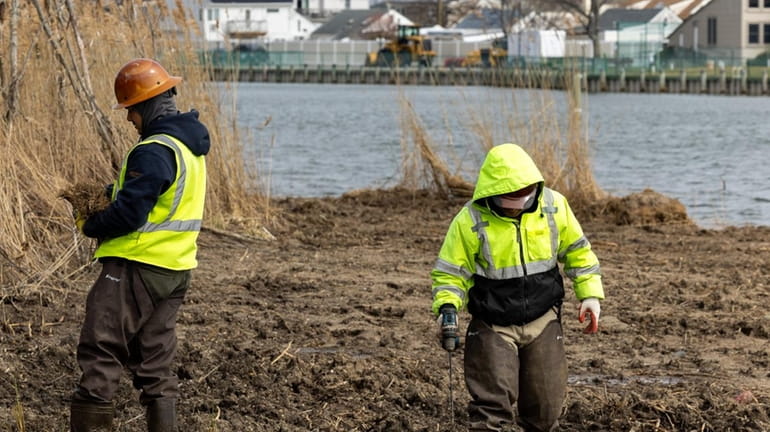Babylon fortifying water's edge to fight erosion at town park

Workers were busy planting beach grass recently for a shore stabilization project at Tanner Park in Copiague that the Town of Babylon is funding largely with federal pandemic relief money. Credit: Newsday/J. Conrad Williams Jr.
The Town of Babylon is shoring up its shore.
The town is finishing a shoreline stabilization project aimed at protecting an eastern section of Tanner Park in Copiague near the marina. The nearly $500,000 erosion-fighting project has been years in the making after town officials first noticed nature’s effect on the site following Superstorm Sandy in 2012.
The town allows Suffolk County to use an area that abuts the park as a depository for sediment after dredging local canals, according to Brian Zitani, the town’s waterways management supervisor.
He said the park's shoreline erosion had begun to encroach on the area and if it caused the perimeter walls of the dredge depository to collapse, about 20,000 yards of sludge could enter the Great South Bay.
Tanner Park Shoreline Project
Length: About 800 feet of shoreline
Method: Rocks, beach grass and coir logs
Cost: Nearly $500,000
“As time went on we noticed the shore was continuing to erode and in the last couple of years, it got to the point where it was starting to erode the bank on the dredge spoil site and that caught our attention,” Zitani added.
The town also was concerned about the impact the erosion could have on nearby Howell Creek, which was dredged two years ago, said Babylon Deputy Supervisor Tony Martinez.
He said if erosion at Tanner Park is not addressed, what gets washed away there will end up in the mouth of the creek.
“This will give the life of the dredging a lot more time,” Martinez added.
The town is using a hybrid approach with a combination of rocks, native plantings and coir logs — an erosion control method that uses coconut husks bound in a biodegradable netting. About 400 feet of the shoreline will have rocks while another 400 feet will have beach grass, Zitani said.
Babylon is using $444,500 in federal pandemic recovery money to pay for the construction and $45,725 in town funding to cover engineering and other related costs.
The project, which requires permits from the New York State Department of Environmental Conservation, has been more than two years in the making, Zitani said.
The state's preference was for the town to not use rocks on the shoreline, but Zitani said the stones are necessary due to the wave action at the site.
“We’d love to see as much green shoreline as possible but there are situations where it’s just not practical,” the town official said.
Zitani estimated 95% of Babylon’s bay shoreline is private property with bulkheading and said because of that the town is focusing on fighting land loss in the exposed areas. The waterways management supervisor said Babylon officials are aiming to tackle a section near Grand Canal in Lindenhurst next, and then plan to shore up another area across from Tanner Park in Amity Harbor.
“It’s those remaining ones that aren’t protected where we’re really noticing, OK this has eroded to the point where the land isn’t going to exist anymore in a couple of years so we need to start taking action,” Zitani added.
Henry Bokuniewicz, a Stony Brook University oceanography professor and beach erosion expert, said he thinks the town is taking a “reasonable approach” that’s appropriate for the park's location given the “alarming” waves the wind can sometimes produce there.
“If you can employ nature to solve your problem or mimic the natural protection, in the long run it’s probably the better solution,” he said. “But sometimes you’re up against the wall and you just can’t beat rocks.”

